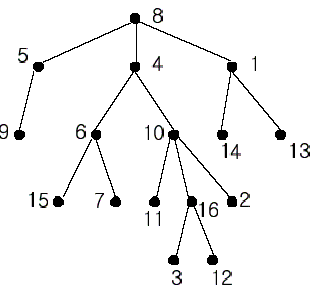POJ 1330 Nearest Common Ancestors 【最近公共祖先LCA算法+Tarjan离线算法】
| Time Limit: 1000MS | Memory Limit: 10000K | |
| Total Submissions: 20715 | Accepted: 10910 |
Description

In the figure, each node is labeled with an integer from {1, 2,...,16}. Node 8 is the root of the tree. Node x is an ancestor of node y if node x is in the path between the root and node y. For example, node 4 is an ancestor of node 16. Node 10 is also an ancestor of node 16. As a matter of fact, nodes 8, 4, 10, and 16 are the ancestors of node 16. Remember that a node is an ancestor of itself. Nodes 8, 4, 6, and 7 are the ancestors of node 7. A node x is called a common ancestor of two different nodes y and z if node x is an ancestor of node y and an ancestor of node z. Thus, nodes 8 and 4 are the common ancestors of nodes 16 and 7. A node x is called the nearest common ancestor of nodes y and z if x is a common ancestor of y and z and nearest to y and z among their common ancestors. Hence, the nearest common ancestor of nodes 16 and 7 is node 4. Node 4 is nearer to nodes 16 and 7 than node 8 is.
For other examples, the nearest common ancestor of nodes 2 and 3 is node 10, the nearest common ancestor of nodes 6 and 13 is node 8, and the nearest common ancestor of nodes 4 and 12 is node 4. In the last example, if y is an ancestor of z, then the nearest common ancestor of y and z is y.
Write a program that finds the nearest common ancestor of two distinct nodes in a tree.
Input
Output
Sample Input
2 16 1 14 8 5 10 16 5 9 4 6 8 4 4 10 1 13 6 15 10 11 6 7 10 2 16 3 8 1 16 12 16 7 5 2 3 3 4 3 1 1 5 3 5
Sample Output
4
3
题目分析:T组数据,每组有n个节点,n-1条边,所以必定会是一棵树。每组输入的最后一行是两个点u, v。问你u和v的最近公共祖先是谁?
Tanjan离线算法。
#include <stdio.h>
#include <string.h>
#include <stdlib.h>
#include <math.h>
#include <vector>
#include <algorithm>
#define N 10000+10
using namespace std;
int n; int s, e;
vector<int>q[N];
int fa[N];
bool vis[N];
bool root[N];//标记该点是不是根节点
int findset(int x) //压缩路径并查集
{
return fa[x]!=x?fa[x]=findset(fa[x]):x;
}
void LCA(int u)
{
for(int i=0; i<q[u].size(); i++)
{
LCA(q[u][i]);
if(findset(u) != findset(q[u][i]))
{
fa[fa[q[u][i]]] = fa[u]; //合并
}
}
vis[u]=true;
if(u==s && vis[e]==true )
{
printf("%d\n", findset(e));
return ;
}
if(u==e && vis[s]==true )
{
printf("%d\n", findset(s));
return ;
}
}
int main()
{
int t;
scanf("%d", &t);
int i, j, k;
int u, v;
while(t--)
{
scanf("%d", &n); //n个节点
//初始化
for(i=0; i<=n; i++){
q[i].clear();
fa[i]=i; //将父亲节点设为自己
root[i]=true;
vis[i]=false; //标记未访问
}
for(i=0; i<n-1; i++)
{
scanf("%d %d", &u, &v); //u是v的父亲节点
q[u].push_back(v);
root[v]=false;
}
scanf("%d %d", &s, &e);
for(i=1; i<=n; i++)
{
if(root[i]==true )//该点是根节点
{
LCA(i); //进行LCA一次离线算法
break;
}
}
}
return 0;
}
郑重声明:本站内容如果来自互联网及其他传播媒体,其版权均属原媒体及文章作者所有。转载目的在于传递更多信息及用于网络分享,并不代表本站赞同其观点和对其真实性负责,也不构成任何其他建议。





































